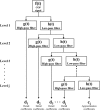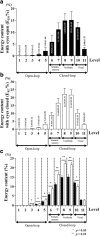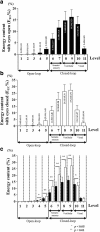Analysis of sensory system aspects of postural stability during quiet standing in adolescent idiopathic scoliosis patients
- PMID: 29929530
- PMCID: PMC6013903
- DOI: 10.1186/s12984-018-0395-6
Analysis of sensory system aspects of postural stability during quiet standing in adolescent idiopathic scoliosis patients
Abstract
Background: The aim of this study was to quantitatively analyze quite standing postural stability of adolescent idiopathic scoliosis (AIS) patients in respect to three sensory systems (visual, vestibular, and somatosensory).
Method: In this study, we analyzed the anterior-posterior center of pressure (CoP) signal using discrete wavelet transform (DWT) between AIS patients (n = 32) and normal controls (n = 25) during quiet standing.
Result: The energy rate (∆E EYE %) of the CoP signal was significantly higher in the AIS group than that in the control group at levels corresponding to vestibular and somatosensory systems (p < 0.01).
Conclusions: This implies that AIS patients use strategies to compensate for possible head position changes and spinal asymmetry caused by morphological deformations of the spine through vestibular and somatosensory systems. This could be interpreted that such compensation could help them maintain postural stability during quiet standing. The interpretation of CoP signal during quiet standing in AIS patients will improve our understanding of changes in physical exercise ability due to morphological deformity of the spine. This result is useful for evaluating postural stability before and after treatments (spinal fusion, bracing, rehabilitation, and so on).
Keywords: Adolescent idiopathic scoliosis (AIS); Balance; Discrete wavelet transform (DWT); Postural stability; Sensory system; Somatosensory; Vestibular; Visual.
Conflict of interest statement
Ethics approval and consent to participate
All experimental protocol was approved by the Institutional Review Boards of Korea University Guro Hospital. All experiments were performed in accordance with relevant approved guidelines and regulations of Sungkyunkwan University.
Consent for publication
Not applicable
Competing interests
The authors declare that they have no competing interests.
Publisher’s Note
Springer Nature remains neutral with regard to jurisdictional claims in published maps and institutional affiliations.
Figures






Similar articles
-
Relations between standing stability and body posture parameters in adolescent idiopathic scoliosis.Spine (Phila Pa 1976). 2002 Sep 1;27(17):1911-7. doi: 10.1097/00007632-200209010-00018. Spine (Phila Pa 1976). 2002. PMID: 12221357
-
Postural adjustments in adolescent idiopathic thoracic scoliosis during walking.Gait Posture. 2019 Feb;68:423-429. doi: 10.1016/j.gaitpost.2018.12.024. Epub 2018 Dec 18. Gait Posture. 2019. PMID: 30594870
-
Balance control in adolescents with idiopathic scoliosis and disturbed somatosensory function.Spine (Phila Pa 1976). 2006 Jun 15;31(14):E437-40. doi: 10.1097/01.brs.0000222048.47010.bf. Spine (Phila Pa 1976). 2006. PMID: 16778672
-
The effect of orthotic interventions on balance performance in adolescent idiopathic scoliosis: A systematic literature review.Assist Technol. 2020 Sep 2;32(5):260-267. doi: 10.1080/10400435.2018.1539419. Epub 2019 Jan 2. Assist Technol. 2020. PMID: 30601092
-
Neurophysiological, balance and motion evidence in adolescent idiopathic scoliosis: A systematic review.PLoS One. 2024 May 22;19(5):e0303086. doi: 10.1371/journal.pone.0303086. eCollection 2024. PLoS One. 2024. PMID: 38776317 Free PMC article.
Cited by
-
Posterior Correction and Fusion Using a 4D Anatomical Spinal Reconstruction Technique Improves Postural Stability Under the Eye-Closed Condition in Patients with Adolescent Idiopathic Scoliosis.J Clin Med. 2024 Oct 24;13(21):6366. doi: 10.3390/jcm13216366. J Clin Med. 2024. PMID: 39518504 Free PMC article.
-
Phybrata Digital Biomarkers of Age-Related Balance Impairments, Sensory Reweighting, and Intrinsic Fall Risk.Med Devices (Auckl). 2025 Jun 11;18:319-336. doi: 10.2147/MDER.S522827. eCollection 2025. Med Devices (Auckl). 2025. PMID: 40524937 Free PMC article.
-
Displacement of Centre of Pressure during Rehabilitation Exercise in Adolescent Idiopathic Scoliosis Patients.J Clin Med. 2021 Jun 27;10(13):2837. doi: 10.3390/jcm10132837. J Clin Med. 2021. PMID: 34198971 Free PMC article.
-
Deficits of Sensory Integration and Balance as Well as Scoliotic Changes in Young Schoolgirls.Sensors (Basel). 2023 Jan 19;23(3):1172. doi: 10.3390/s23031172. Sensors (Basel). 2023. PMID: 36772216 Free PMC article.
-
Changes in postural stability after cerebrospinal fluid tap test in patients with idiopathic normal pressure hydrocephalus.Front Neurol. 2024 May 1;15:1361538. doi: 10.3389/fneur.2024.1361538. eCollection 2024. Front Neurol. 2024. PMID: 38751889 Free PMC article.
References
-
- Cheung CWJ, Zheng Y. Development of 3-D ultrasound system for assessment of adolescent idiopathic scoliosis (AIS) In: Lim CT, JCH G, editors. WCB 2010, IFMBE Proceedings. 2010. pp. 584–587.
-
- Cheung CJ, Law S, Zheng Y. Development of 3-D ultrasound system for assessment of adolescent idiopathic scoliosis (AIS): and system validation. Conf Proc IEEE Eng Med Biol Soc. 2013:6474–7. - PubMed
Publication types
MeSH terms
LinkOut - more resources
Full Text Sources
Other Literature Sources
Medical

